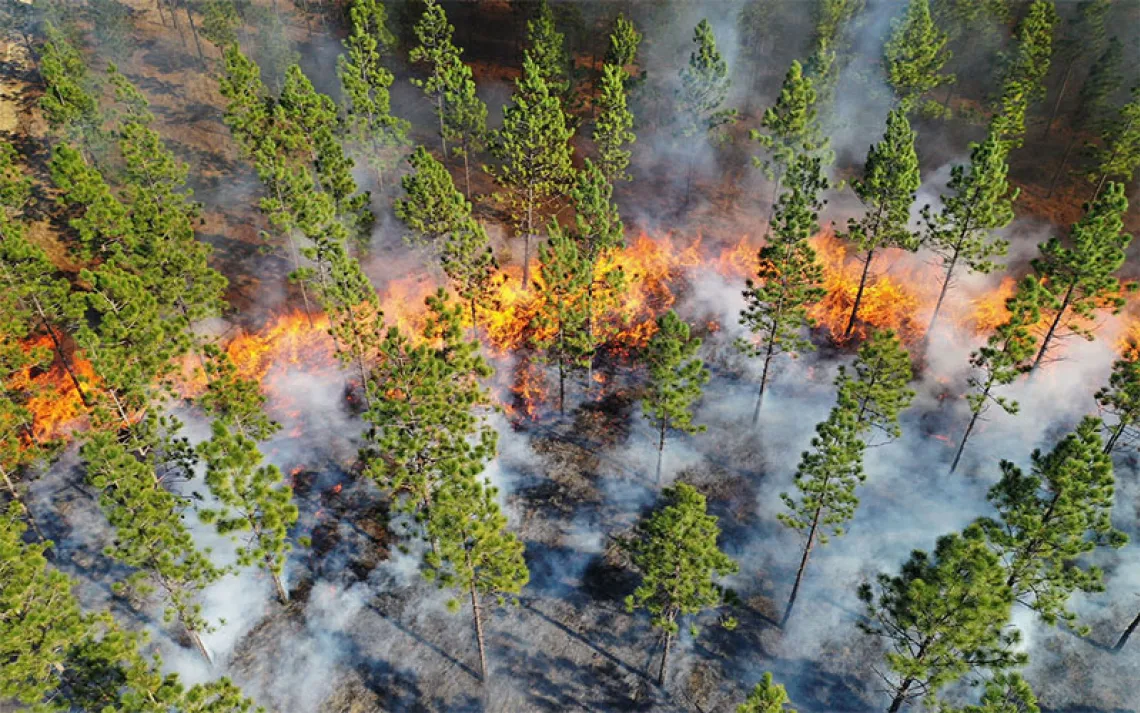Rebecca Jim and the Legacy of Tar Creek
The lifelong activist brings people together to heal the land

Rebecca Jim has dedicated her life to cleaning up Tar Creek and warning others about the area's toxic dangers. | Photos by Cody Hammer
Rebecca Jim lives on 490 acres of tallgrass prairie in northeastern Oklahoma. A creek runs by her house, which she built with her father in her twenties. Persimmon, walnut, pecan, and pine trees that she planted herself offer shade. Most years she tends a big garden. The buckbrush that she uses to make baskets grows outside her back door.
For two and a half decades, Jim commuted 25 miles east to the town of Miami (pronounced my-am-ah), in Ottawa County, where she worked as a counselor for Native American students at the junior high and high school (about 20 percent of the county's population is Indigenous). During that time, Jim, who is Cherokee, never lost sight of the fact that while she resided in a beautiful place where she could live off the land and safely practice her cultural traditions, her students did not. Their families lived in and around Tar Creek, the oldest Superfund site in the United States: 40 square miles of toxic air, soil, and water.
In the first half of the 20th century, northeastern Oklahoma was mined heavily for zinc and iron ore. By the 1960s, the mines had closed and the mining companies had left behind a landscape dotted with deserted mine shafts, tailing ponds, and enormous piles of chat, a byproduct from processing ore that looks like dirt and gravel.
One day in 1979, soon after Jim had begun her job as a counselor in Miami, the small creek that wound through the town turned orange. The mines had been built on top of an aquifer and, when operating, had been pumped to stay dry. Once closed, they had gradually refilled and finally overflowed, pouring out a toxic soup of ore, zinc, cadmium, and other heavy metals. At least a million gallons of mine water a day were flowing downstream—sometimes much more. "Tar Creek was the treasure of the town," Jim says. "The people I worked with fished in it every day. My students swam in it."

In 1983, the EPA declared the area the Tar Creek Superfund site. The agency tried a few tactics to improve the water quality, then gave up. It took another 10 years for residents to realize the full scope of the problem.
In the early 1990s, the Indian Health Service discovered that a third of the children at the clinic in Miami had elevated levels of lead in their blood. In nearby Picher, 34 percent of the children were found to be suffering from lead poisoning. One of the main sources of exposure was the chat piles dominating the skyline. Kids played on them, climbing up and sliding down. Wind blew the dust into people's houses. Towns built playgrounds with chat; fathers filled sandboxes.
For Jim, the grim news made sense. She had grappled with high rates of learning and behavioral problems among her students—common outcomes for kids exposed to lead. She told herself, "We have to do everything we can do to lower those rates."
The EPA launched a large-scale project to replace the soil in yards and parks, but the chat piles and polluted water remained. Jim and her students decided that people needed to understand the risks. They began taking kids from surrounding schools on "toxic tours" to show them the damage. They made posters and flyers instructing residents to wash their hands frequently and wipe down surfaces.
Before long, the whole school was involved. Math students calculated the percentage of heavy metals in the water; English students wrote poetry about their devastating impacts. Sophomores collaborated with scientists studying Tar Creek for a required environmental research project, and Jim and her students started a tooth fairy project, collecting baby teeth so they could be tested for lead.
Jim hesitates to take credit for these efforts, saying, "I just stirred the pot." But her effect on students was profound. Melanie White was in high school in the mid-'90s. Jim, she says, was all about getting information out: "There were no secrets with her, and that's what I loved." White, who is Cherokee, also credits Jim with connecting her to her heritage. "She helped me grow my backbone," White says. "She has a soft, kind heart, but when you look in her eyes, you see steel. As we say around here, dynamite comes in small packages."

Make every day an Earth Day
Get articles like this one sent directly to your inbox.
With this action you affirm you want to receive Sierra Club communications and may vote on policy designated by the Sierra Club Board.
In 1997, Jim cofounded the agency Local Environmental Action Demanded (LEAD), and she remains its executive director. She retired from her counseling job in 2001. As Jim explains it, LEAD is doing what the students did—conducting toxic tours, pushing for more cleanup funds, and organizing the annual Tar Creek Conference, now in its 23rd year.
Bob Nairn, an engineering and environmental science professor at the University of Oklahoma, met Jim on a toxic tour in the late '90s. "No matter how many roadblocks occur, she doesn't give up," he says. Nairn and his students regularly attend the Tar Creek Conference, which brings together universities, state and federal agencies, and tribes for what Nairn calls "a few days of information sharing and fellowship." Jim has spent decades building out this web of relationships—an intensive emotional labor that's hard to quantify but that ensures that the people of Tar Creek aren't forgotten.
Nairn has overseen the construction of two passive water-treatment systems that send half a million gallons of clean water a day back into Tar Creek, a solution that he thinks with proper funding can be scaled up. Jim wholeheartedly agrees.
"We're going to end up with a wastewater-treatment system right where that bad water enters," she says. "We're going to cap that mine waste. Children are going to play here again."
This article appeared in the Winter quarterly edition with the headline "The Legacy of Tar Creek."
 The Magazine of The Sierra Club
The Magazine of The Sierra Club



